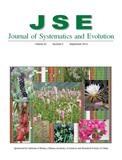Feng-Juan MOU, Dian-Xiang ZHANG
Chromosome numbers for 21 Rutaceous species, representing five genera (Bergera, Clausena, Glycosmis, Micromelum, and Murraya) in the tribe Clauseneae (Aurantioideae, Rutaceae) were investigated to shed light on the relationships between these genera in the tribe in particular, and with other groups in the orange subfamily in general. Most species have the chromosome number 2n= 2x= 18, but Glycosmis shows variable chromosome numbers with ploidy levels ranging from 2x to 8x. Glycosmis parviflora is hexaploid with a chromosome number of 2n= 6x= 54 and G. longipetala octoploid with 2n= 8x= 72, and diploid with 2n= 2x= 18 was observed in other species. One species (Clausena excavata) shows intraspecies ploidy variation. The chromosome numbers of 11 species, Bergera kwangsiensis, B. microphylla, Clausena dunniana, C. emarginata, C. lenis, C. yunnanensis, Glycosmis esquirolii, G. lucida, G. oligantha, Micromelum falctum, and Murraya alata, are reported for the first time. The basic chromosome number x= 9 was inferred for all species studied. These results, together with previous chromosome counts in the tribe Citreae, reveal a cytological homogeneity, and strongly support the monophyly of the orange subfamily.

